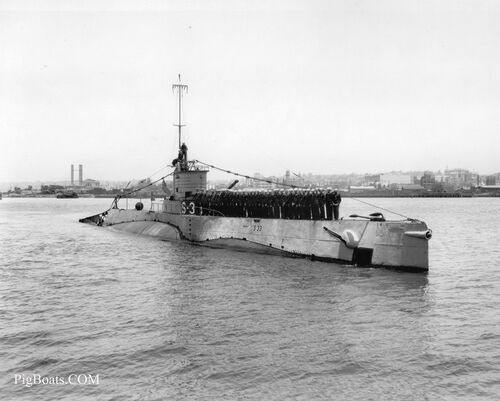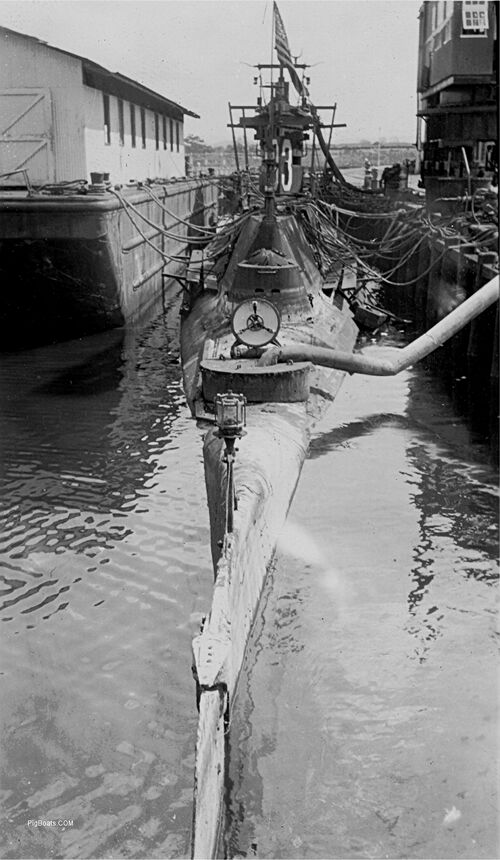S-33: Difference between revisions
Pbcjohnston (talk | contribs) (Created S-33 page) |
Pbcjohnston (talk | contribs) (Added 1922 photo) |
||
| (2 intermediate revisions by the same user not shown) | |||
| Line 1: | Line 1: | ||
[[File:S-Boat Header 1.jpg]] | [[File:S-Boat Header 1.jpg]] | ||
<div style="text-align: justify;"><span style="color:#00008B"> | [[File:S-33 at San Pedro 1922.jpg|left|500px]] | ||
<div style="text-align: justify;"><span style="color:#00008B">S-33 maneuvering up to moor at either San Pedro or the Bethlehem piers at San Francisco, April 1922. This is likely shortly after her commissioning on April 18. Only her Navy crew is topside and they are in their dress blue uniforms. The boat is very nearly at a standstill and is maneuvering on the battery; there is no engine exhaust, indicating that the engines are shut down. Curiously, a portion of the superstructure plating on the aft skeg is missing, leaving the internal framework visible. The reason for this is unknown, and is especially curious at this early point in her career. It may be due to the problems the boat was having with her engines. | |||
The location is not entirely certain, but there were only two west coast ports she was in prior to heading east to Groton, CT. for her engine rebuild work. In the left background is a building with a large "Western Lumber Company" sign on it. Western Lumber was a prominent company on the U.S. west coast at the time and they had locations in both San Pedro (Los Angeles harbor) and San Francisico. Upon her commissioning at San Francisco, S-33 operated very briefly out of San Pedro before making the long journey at reduced power down through the Panama Canal and up the east coast to Groton. | |||
<small>Photo in the private collection of Dave Johnston.</small> | |||
[[File:Red bar sub new.jpg]] | |||
[[File:S-33 refit.jpg|left|500px]] | |||
An undated photo of S-33 but most likely circa mid 1930's, possibly Cavite or Pearl Harbor. We can't identify the location, but it appears to be a navy yard of some sorts. The date is after modifications that lead to the cutting away of the after superstructure and installation of the messenger buoy. The sub is sitting at the dock with a bow down angle. This unusual down angle is to keep the open motor room hatch clear of the water, which at normal trim is right at the waterline. They needed the hatch open for work, so they wanted to raise it above the waterline to prevent accidental flooding. You can see the waterline marks on the hull and around the messenger buoy fairing. | |||
Quite extensive work is being done by the number of power lines and air hoses leading from the dock to the sub. There is ventilation ducting leading to the sub's motor room hatch and bridge to either force cool air in or carry away fumes from possible welding and burning. | |||
<small>Photo in the private collection of Ric Hedman.</small> | <small>Photo in the private collection of Ric Hedman.</small> | ||
Latest revision as of 11:56, 20 September 2024

The location is not entirely certain, but there were only two west coast ports she was in prior to heading east to Groton, CT. for her engine rebuild work. In the left background is a building with a large "Western Lumber Company" sign on it. Western Lumber was a prominent company on the U.S. west coast at the time and they had locations in both San Pedro (Los Angeles harbor) and San Francisico. Upon her commissioning at San Francisco, S-33 operated very briefly out of San Pedro before making the long journey at reduced power down through the Panama Canal and up the east coast to Groton.
Photo in the private collection of Dave Johnston.

An undated photo of S-33 but most likely circa mid 1930's, possibly Cavite or Pearl Harbor. We can't identify the location, but it appears to be a navy yard of some sorts. The date is after modifications that lead to the cutting away of the after superstructure and installation of the messenger buoy. The sub is sitting at the dock with a bow down angle. This unusual down angle is to keep the open motor room hatch clear of the water, which at normal trim is right at the waterline. They needed the hatch open for work, so they wanted to raise it above the waterline to prevent accidental flooding. You can see the waterline marks on the hull and around the messenger buoy fairing.
Quite extensive work is being done by the number of power lines and air hoses leading from the dock to the sub. There is ventilation ducting leading to the sub's motor room hatch and bridge to either force cool air in or carry away fumes from possible welding and burning.
Photo in the private collection of Ric Hedman.
Page created by:
Ric Hedman & David Johnston
1999 - 2023 - PigBoats.COM©
Mountlake Terrace, WA, Norfolk, VA
webmaster at pigboats dot com
